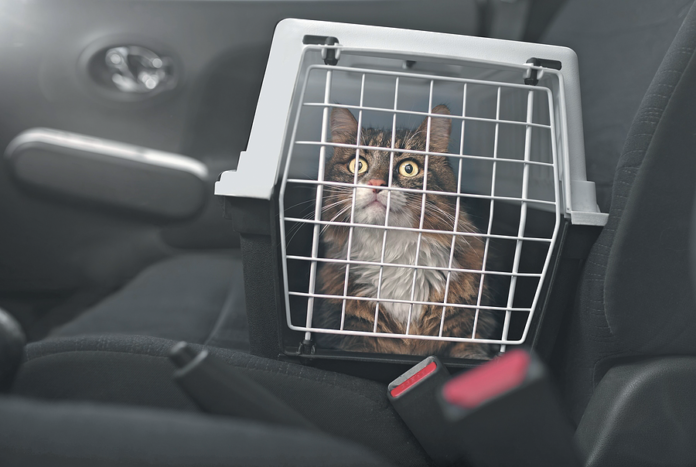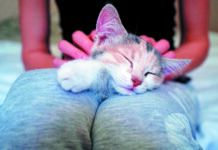You have to take your cat to the vet’s office, so you put her in her carrier, place it on the back seat, and then attach the carrier to the seat by running the seatbelt through the handle or straps before clicking the buckle, right? Wrong.
If you don’t have a crash protection carrier, the best bet for keeping your cat safe is to put the carrier on the floor of the vehicle behind the driver’s seat or the front passenger seat. Many carriers for cats (and small dogs) that are secured with a seatbelt on the back seat can get crushed in an accident. They are too hard and can easily fracture because they don’t have the structural integrity to hold up as the belt pulls on them during impact. Or a failure in stitching can create a hole in carriers with soft sides, say, where the handles attach to the cat-holding compartment. Such holes can easily be breached by a scared feline, who is more apt to get hurt in a crash if she has clamored outside the enclosure.
So how do you find a safe enough carrier? It would seem that all you have to do is look for products marketed as having been tested for crashes. But that’s wrong, too. Where do you turn?
The Center for Pet Safety
Some years ago, Lindsey Wolko put her small dog into a harness in the back of her car to keep her pet restrained for a ride along iconic Route 66. But when Ms. Wolko had to stop short, the little canine slammed into the back seat and suffered a strained spine and hip. She couldn’t walk up the stairs for a while, even with painkillers.
The incident led Ms. Wolko to do some searching, which is when she found that while many pet carriers and harnesses are marketed as having been tested for safety, they have not actually passed rigorous crash tests. That’s because there is no federal standard for “safe” when it comes to keeping pets from harm during auto travel. It leaves manufacturers free to call something safe without sufficient proof.
It’s for that reason that she started the non-profit Center for Pet Safety, based outside of Washington, DC, in Reston, Virginia. The organization accepts no funding from makers of pet products, which keeps its work completely free from industry influence.
One of the first things the Center for Pet Safety did was create rigorous product testing requirements in order for manufacturers to be able to qualify for certification that actually means something. Any product chosen or submitted voluntarily for safety testing during simulated crashes is evaluated for the quality of its hardware and stitching and, of course, its ability to stay intact and keep a pet safely restrained in the event of an accident.
The organization works on behalf of pet owners of both cats and dogs, so certain car safety products have passed standards that are meaningful for our feline friends. They tend to be significantly more expensive than many of the products out there ($200 to $300), but as the Center for Pet Safety explains on its website (centerforpetsafety.org), “Manufacturers who complete ample research and development to ensure their product performs well spend a lot of money on product testing. Those research and development dollars are absorbed in the overall cost of the product.”
Granted, your cat probably doesn’t go in the car much, but her safety for trips to the vet — or boarder’s if you’re going away — is something to weigh against the cost.
➤ Gunner Kennel G1 Small with Strength-Rated Anchor Straps
➤ Sleepypod Carriers
➤ Away carrier (the first luggage brand to certify)
*The Center for Pet Safety uses the maximum weight specified by the pet product brand to ensure a robust crash test. At the end of the test, it takes measurements from a video along with physical measurements to assess how the product held up on impact. With those measurements, it makes comparisons to its grading scale and awards points for each area of measurement. If the brand has enough points at the end of the test, it is certified with either a 5- or 4-star rating. Anything below those two ratings is “not recommended.” The brand must also agree to significant terms developed in the consumer interest—including transparency if the manufacturer makes any changes (triggering a mandatory retest) other than cosmetic changes like expanding its color options. In addition, companies must continually monitor their quality control and re-certify every 2 years. Finally, the Center for Pet Safety is very strict about the types of marketing language the brands may use.
Note: While the Center for Pet Safety recommends certain carriers for cats, it does not recommend harnesses to strap in feline pets, as it does for dogs. As the center’s founder Lindsey Wolko says, “cats are too often escape artists.”





Once moved into an apartment (w/ 3 cats) on the way over-Akemi didn’t make a peep, Neko meowed 4 times, & Toshi said “meh” all the way over.